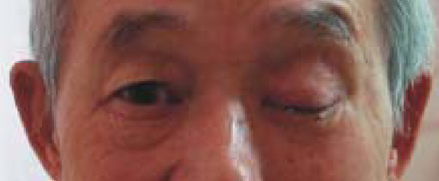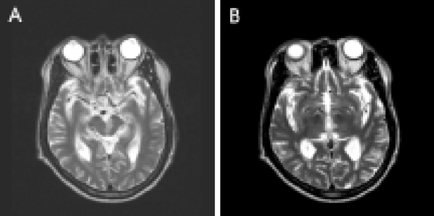J Clin Neurol.
2006 Mar;2(1):78-81. 10.3988/jcn.2006.2.1.78.
Truncal Contrapulsion in Pretectal Syndrome
- Affiliations
-
- 1Department of Neurology, Seoul National University Hospital, Seoul, Korea. rohjk@snu.ac.kr
- 2Department of Neurology, Seoul National University Bundang Hospital, Seongnam, Seoul, Korea.
- 3Department of Neurology, Soonchunhyang University Hospital, Seoul, Korea.
- KMID: 2287708
- DOI: http://doi.org/10.3988/jcn.2006.2.1.78
Abstract
- Truncal contrapulsion in association with pretectal syndrome has not been described previously. We report a patient with vertical-gaze palsy and severe truncal contrapulsion due to an infarction in the mesodiencephalic junction. Truncal contrapulsion in this patient may have resulted from the disruption of the ascending fibers in the crossed cerebellothalamic tract.
Keyword
MeSH Terms
Figure
Reference
-
1. Keane JR. The pretectal syndrome: 206 patients. Neurology. 1990. 40:684–690.2. Thomke F, Marx JJ, Iannetti GD, Cruccu G, Fitzek S, Urban PP, et al. A topodiagnostic investigation on body lateropulsion in medullary infarcts. Neurology. 2005. 64:716–718.
Article3. Masdeu JC, Gorelick PB. Thalamic astasia: inability to stand after unilateral thalamic lesions. Ann Neurol. 1988. 23:596–603.
Article4. Sharpe JA, Kim JS. Midbrain disorders of vertical gaze: a quantitative re-evaluation. Ann N Y Acad Sci. 2002. 956:143–154.5. King WM, Fuchs AF. Reticular control of vertical saccadic eye movements by mesencephalic burst neurons. J Neurophysiol. 1979. 42:861–876.
Article6. Suzuki Y, Büttner-Ennever JA, Straumann D, Hepp K, Hess BJM, Henn V. Deficits in torsional and vertical rapid eye movements and shift of Listing's plane after uni- and bilateral lesions of the rostral interstitial nucleus of the medial longitudinal fasciculus. Exp Brain Res. 1995. 106:215–232.
Article7. Fukushima K, Fukushima J, Harada C, Ohashi T, Kase M. Neuronal activity related to vertical eye movement in the region of the interstitial nucleus of Cajal in alert cats. Exp Brain Res. 1990. 79:43–64.
Article8. Handel A, Glimcher PW. Response properties of saccade-related burst neurons in the central mesencephalic reticular formation. J Neurophysiol. 1997. 78:2164–2175.
Article9. Waitzman DM, Silakov VL, DePalma-Bowles S, Ayers AS. Effects of reversible inactivation of the primate mesencephalic reticular formation. II. Hypometric vertical saccades. J Neurophysiol. 2000. 83:2285–2299.
Article10. Kokkoroyannis T, Scudder CA, Balaban CD, Highstein SM, Moschovakis AK. Anatomy and physiology of the primate interstitial nucleus of Cajal I. efferent projections. J Neurophysiol. 1996. 75:725–739.
Article11. Moschovakis AK, Scudder CA, Highstein SM. Structure of the primate oculomotor burst generator. I. Medium-lead burst neurons with upward on-directions. J Neurophysiol. 1991. 65:203–217.
Article12. Keane JR, Davis RL. Pretectal syndrome with metastatic malignant melanoma to the posterior commissure. Am J Ophthalmol. 1976. 82:910–914.
Article13. Schmidtke K, Büttner-Ennever JA. Nervous control of eyelid function. A review of clinical, experimental and pathological data. Brain. 1992. 115:227–247.14. Kataoka H, Sugie K, Kohara N, Ueno S. Novel representation of astasia associated with posterior cingulated infarction. Stroke. 2006. 37:e3–e5.15. Karimi M, Razavi M, Fattal D. Rubral lateropulsion due to vertebral artery dissection in a patient with Klippel-Feil syndrome. Arch Neurol. 2004. 61:583–585.
Article16. Sohn SI, Lee H, Lee SR, Baloh RW. Cerebellar infarction in the territory of the medial branch of the superior cerebellar artery. Neurology. 2006. 66:115–117.
Article
- Full Text Links
- Actions
-
Cited
- CITED
-
- Close
- Share
- Similar articles
-
- Ocular Contrapulsion in Medial Medullary Infarction
- Convergence-related Nystagmus in a Patient with Hydrocephalus from Shunt Malfunction
- Multiple Germ Cell Tumors Manifesting as Anterior Hypothalamic and Pretectal Syndromes
- Complications and sequelae of truncal vagotomy
- Clinical study of truncal vagotomy with pyloroplasty for perforation of duodenal ulcer



